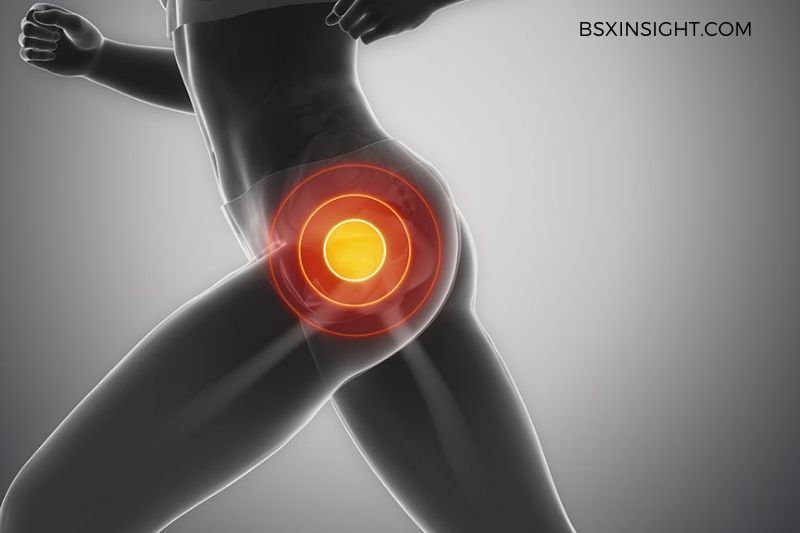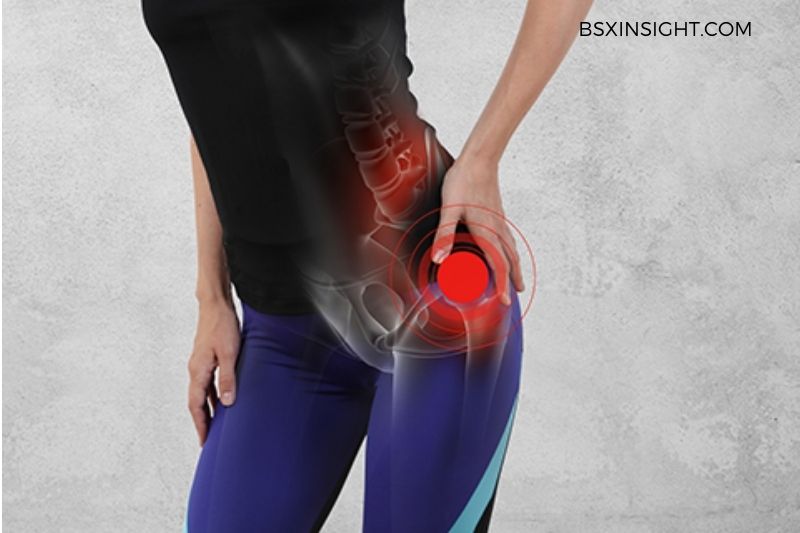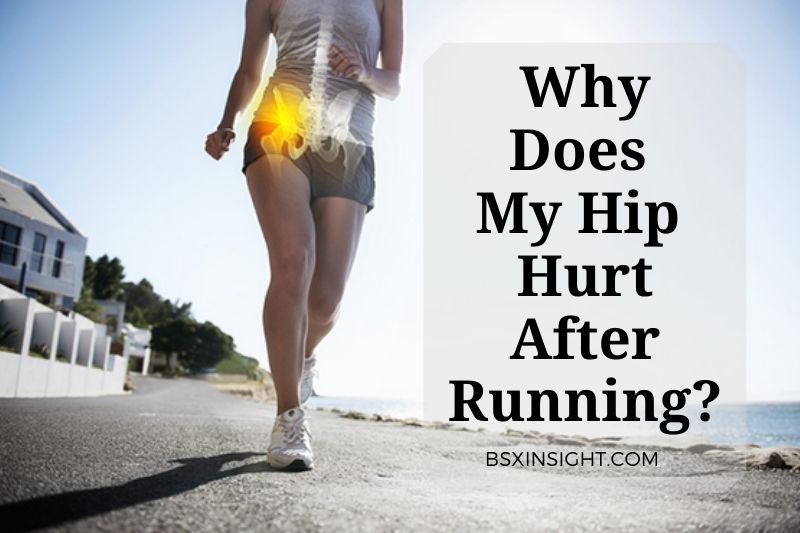- BSX Insight
Why does my hip hurt after running? Hip pain is a common injury for runners, and it’s a common one. It can be difficult to determine what is causing your pain after running. If you’re experiencing hip pain, BSXInsight has everything you need to learn about hip injuries and how to treat them.
What is A Runner’s Hip?
A runner’s hip is a condition that can cause pain in the hip joint. The condition is caused by overuse of the hip joint, which can lead to inflammation and pain. Treatment for a runner’s hip typically includes rest, ice, and anti-inflammatory medication.
The hips are vital joints for a strong and powerful running stride, but they are also at risk for various musculoskeletal injuries. Let’s review the basic anatomy of the hips before we cover common causes of hip pain in runners.
The hips are the largest synovial joints in the body and have a ball-and-socket configuration. The head of your femur (thigh bone) articulates into the concave acetabulum (socket) formed by the pelvis bones.
The ball-and-socket configuration makes the hip highly mobile, allowing forwarding flexion and backward extension, lateral abduction (out to the side), adduction, and internal and external rotation.
The hip joint is controlled by several large and small muscles, which work together to carry out these movements in a controlled and powerful fashion.
For example, several synergistic muscles make up the hamstrings and glutes, which help extend the hip together. The Iliopsoas group of muscles is responsible for flexing the hip. Smaller, deeper muscles like the piriformis, tensor fascia latae, gemellus superior and inferior, and obturators help with rotation. There is a large group of adductors in the inner thigh, among others.
While you don’t need to be an anatomy buff or memorize every muscle to prevent hip pain after running, the takeaway is that hip motions are highly complex, and it’s important for runners to engage in a well-rounded routine of exercises that increase the strength and mobility of the hip musculature.
Why Are Hips a Problem?
It’s crucial that everyone understands the human anatomy we’re talking about before we go into what hurts and why.
The region on each side of the pelvis is referred to as the hips. The top of the thigh bone, which rests in a unique socket within the pelvis, forms the hip joint (called the acetabulum). This joint, which also permits motion and stability, is what enables you to support your body weight on your legs. The hip joint is actually among the most stable in the entire body, but due to the enormous strain it endures, it is also more prone to developing arthritis.
Strong hip ligaments help to support the hip joint, avoid dislocation, and prevent hyperextension. They also work to prevent hyperextension.
The hip joint also depends heavily on the muscles. Hip flexors, extensors, adductors, abductors, internal rotators, and external rotators are some of them.
Why Does My Hip Hurt After Running?

Most common causes of hip pain after running. Some conditions are more severe than others.
Muscle Strains
The hip is a large joint and is used extensively in running, so it’s not surprising that this is a common injury. Muscle strains can occur in any of the muscles that support the hip, including the gluteus medius, piriformis, and hamstrings.
These muscles can become overloaded and develop microscopic tears, resulting in pain and inflammation. Treatment for muscle strain includes rest, ice, and heat, as well as over-the-counter pain medication. In severe cases, physical therapy may be necessary.
Tendonitis
Tendonitis can lead to pain when you run. Tendinitis is caused by inflammation of your tendons, which are the structures that connect your bones and muscles. This often happens if you run longer than usual or don’t take enough rest days for your muscles to heal fully between workouts.
Tendinitis can cause damage to tendons in the hip.
Hip flexors are the muscles that move your leg forward and are used heavily while running. These muscles are required to work harder when you run uphill or sprint. Hip flexor tendonitis is a condition that causes pain in the hips.
Adductors: These are the muscles that move your leg toward your body. They stabilize your pelvis, thigh bone (the Femur), and hip bones when you run. When you run uphill, downhill, or sprint, your adductor muscles are more active. Adductor tendonitis is a condition that causes pain in the inner thigh and groin.
Hamstrings: The hamstrings are three muscles located behind your thighs. These muscles join at the one tendon to your ischial tuberosity, which is the bone you sit on. A running-related injury to the hamstring tendon is often caused by pushing off the ground or sudden stops while running. Long sitting, squatting, and lunging can all cause pain.
Bursitis
Bursae, which are fluid-filled cushions located around your joints throughout the body, are called bursae. Bursitis is a condition where these structures can become inflamed by friction or repeated pressure. Two bursae can cause pain in the hips after running.
The iliopsoas Bursa is located on your front hip, close to your groin. The trochanteric Bursa is found behind the boney point on your hip, just below your pelvis.
Trochanteric Bursitis is a condition that causes pain in the hip (trochanteric bursitis). This condition can lead to pain when you run, climb stairs, squat, or get up from a seat after sitting for a prolonged period. Trochanteric bursitis can worsen at night, especially if you roll onto the affected side.
Iliopsoas Bursitis, which is less common, causes pain in the groin.
Have you also suffered lower back pain when running? Check out our post for more information: Lower Back Pain When Running: Causes And Treatments 2023
Hip Labral Tear
Your hip joint is a ball and socket joint. The ball at your hip’s top fits into the socket in your pelvis. To stabilize your joint, the labrum is a cartilage ring that runs around the socket’s edge.
Wear and tear from repetitive activities like running can cause tears in the labrum. Sharp pain is usually felt near the groin, in the front of your hip. Other symptoms include pain in the hips, difficulty moving the hips, clicking in the hip joint, or feeling locked up.
Osteoarthritis
Osteoarthritis is a condition where the cartilage (or padding between your bones and your joints) gradually wears away. Your bones may rub against one another, causing severe pain.
OA is more common in older people. It is also more common in families. If you have had hip injuries such as labral tears, you are more likely to develop OA in your hip.
You might not feel pain until you are older if you do weight-bearing activities like running. After sitting for a while or getting up in the morning, your hip may feel stiff. Even if you’re not active, eventually, pain will develop.
Stress Fracture
Hip stress fractures occur when your bone is subject to repetitive stress, such as running. These fractures are most common near the ball of the femur rather than the socket of your hip joints.
A hip stress fracture can cause an aching sensation in your hips and groin. The pain is worse when you run or walk but improves when you rest. But, stress fractures can lead to the constant pain.
Iliotibial Band Syndrome
The tendon that runs from the hip to the outside of the thigh to the knee is the iliotibial band. Tightening the band can lead to pain after running, knee pain, or both. It can also cause inflammation.
IT band syndrome is closely related to hip bursitis when the IT band becomes too tight. This causes friction near the hip, which causes pain and inflammation.
IT band syndrome, a common injury that occurs in runners due to overuse, can affect both novice and experienced runners. IT band syndrome can be caused by an abrupt increase in activity (e.g., increased mileage). Other risk factors include running downhill and wearing worn-out shoes.
How Long Does Hip Pain Last After Running?
The duration of hip pain after running can vary depending on the intensity and duration of the run, as well as the person’s individual pain tolerance. In general, however, most people will experience some level of pain for at least a few days after running. For some, this pain may be mild and only last for a day or two. For others, the pain may be more severe and last for several days or even weeks. If the pain is severe or persists for more than a week, it is important to see a doctor or other healthcare provider to rule out any underlying causes.
How are Hip Injuries from Running Treatable?

There are many options for hip pain that results from running. The severity of your hip injury and the duration of your symptoms will determine the treatment you choose.
Conservative Treatment
Hip pain after running can often be treated conservatively, especially if the symptoms are addressed early. The following are some treatments:
Ice and rest: Tendonitis and mild muscle strains can be treated with ice and rest. Ice can be applied to the hip 15-20 minutes at a stretch every one to two hours to relieve hip pain and inflammation and pain. These conditions can be helped by gentle range-of-motion exercises that can reduce stiffness.
Maintain your weight: Stress fractures take six to eight weeks to heal. You will need to reduce your weight by using crutches during that time.
Physical therapy: This is the most common treatment for running-related hip pain. Your symptoms will be treated by a physical therapist who will also examine your running technique in order to determine if you have any weaknesses that could be causing your pain.
Over-the-counter (OTC) pain medications: These medications can be used to relieve pain and inflammation after running. You don’t need a prescription to buy nonsteroidal anti-inflammatory drugs (NSAIDs) such as Aleve, Advil (ibuprofen), Bayer (aspirin), and Advil (ibuprofen), Tylenol (acetaminophen), which can also be used to reduce pain about a week.
Prescription medications: In some cases, prescription-strength pain relievers or oral steroid medications are also used to treat hip injuries.
Also read: How To Breathe While Running? Top Full Guide 2023
Injections
Your healthcare provider may choose to inject medication directly into your hip if oral medications fail to work. Corticosteroids, which are powerful anti-inflammatory medications, are often injected to treat conditions like tendonitis and bursitis.
These medications usually work within two to three days of injection. They are not always very effective and should only be used in a single area. Steroid overuse can actually cause more damage to your tissues.
Hyaluronic acid injections can be used to treat hip osteoarthritis. This substance is used to lubricate the hip joints and reduce stiffness.
Surgery
Surgery may be required for severe hip pain. To restore full function, significant tendon or muscle tears must be repaired. If your labral tear doesn’t respond to conservative treatment, surgery may be necessary to repair the damaged edges.
The treatment of advanced osteoarthritis of the hip can be done with surgery. This includes debridement (cleaning up any rough edges) and a total replacement.
How Can I Prevent Hip Injuries?

Although there is no way to completely prevent hip injuries from running, you can take steps to reduce your risk.
- Strengthen the muscles around the hip. Strong muscles provide support and stability to the joint.
- Increase your flexibility. This will help your muscles and joints to move through their full range of motion, which can help to prevent injuries.
- Use proper form when exercising. This will help to ensure that the muscles and joints are being used correctly and are not being overloaded.
- Wear supportive shoes. This will help to absorb some of the impacts on the hip joint and prevent injuries.
- Avoid high-impact activities. If you have a history of hip injuries or are at risk for them, it is best to avoid activities that put excessive stress on the joint.
Hip Pain From Running Shoes
Make sure you wear the right footwear for your stride. A trained specialist in running will match your shoe to your footstrike. Visit our shops to learn more about Run and Become.
Keep track of how many miles you run in cushioned shoes to ensure they don’t lose their shock absorption.
Avoid overtraining. Do not increase your training intensity, duration, or frequency by more than 10% per week. Your entire body, including your hips, will need to adjust to the increased demands.
Hip Pain Exercises
You can improve your flexibility by doing hip flexor stretches and hamstring stretching, as well as pelvic tilts.
You can strengthen the muscles that are connected to the hip joint by performing specific exercises like squats or lunges. Do resistance exercises at least two days per week.
To improve stability and balance, strengthen your core/torso muscles.
When standing, sitting, and walking, maintain a good posture. This allows your hips to function and move normally without any strain.
FAQs
How do I relieve hip pain from running?
Do 5–10 minutes of brisk walking or easy jogging, followed by dynamic stretches, before beginning your entire workout to help reduce hip soreness after running.
Why outside hip pain after running stretches?
This possible injury should be taken into consideration by runners who experience hip pain on the outside of the hip that gets worse when they run, stroll, climb stairs, get out of a low chair, or get in or out of a car. Pressing on the side of your hip or attempting to sleep on that side will typically make the pain worse.
What is a runner’s hip?
The most common cause of this hip injury in runners is overuse, especially following an increase in speed training or running distance. The pain usually starts out gradually, going away when you finish running but later escalating to persisting when you are at rest.
Conclusion
Hip pain after running is a common complaint among runners of all levels. The pain can range from a dull ache to a sharp, stabbing sensation and can last for days, weeks, or even months.
While the pain may eventually go away on its own, there are several things you can do to speed up the healing process and get back to your regular running routine. Rest is the first and most important step in treating hip pain. Running puts a lot of stress on your hips, so it’s important to give them a break.

